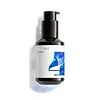What's inside
What's inside
 Key Ingredients
Key Ingredients

No key ingredients
 Benefits
Benefits

 Concerns
Concerns

 Ingredients Side-by-side
Ingredients Side-by-side

Water
Skin ConditioningPropanediol
SolventCetearyl Alcohol
EmollientCeteareth-20
CleansingGlycerin
Humectant1,2-Hexanediol
Skin ConditioningCitrus Aurantium Dulcis Peel Oil
MaskingTocopherol
AntioxidantAloe Barbadensis Leaf Juice
Skin ConditioningTocotrienols
Skin ConditioningCaprylhydroxamic Acid
Helianthus Annuus Seed Oil
EmollientSantalum Spicatum Seed Oil
Skin ConditioningButylene Glycol
HumectantElaeis Guineensis Oil
EmollientMica
Cosmetic Colorant7-Dehydrocholesterol
Emulsion StabilisingCeteareth-25
CleansingPentylene Glycol
Skin ConditioningMagnesium Aspartate
Skin ConditioningZinc Gluconate
Skin ConditioningEthylhexylglycerin
Skin ConditioningPhenoxyethanol
PreservativeCetyl Alcohol
EmollientBanksia Serrata Flower Extract
Skin ConditioningBarklya Syringifolia Flower/Leaf Extract
AntioxidantBrachychiton Acerifolius Flower Extract
AntioxidantCitrus Australasica Fruit Extract
AntioxidantDavidsonia Pruriens Fruit Extract
AntioxidantHibiscus Sabdariffa Flower Extract
Skin ConditioningMelaleuca Alternifolia Leaf Extract
PerfumingSantalum Acuminatum Fruit Extract
AntioxidantTasmannia Lanceolata Fruit Extract
Skin ConditioningTelopea Speciosissima Flower/Leaf Extract
AntioxidantTerminalia Ferdinandiana Fruit Extract
AntioxidantCitric Acid
BufferingBehenic Acid
CleansingCeramide NP
Skin ConditioningCholesterol
EmollientCopper Gluconate
Skin ConditioningPotassium Sorbate
PreservativeCeramide Ns
Skin ConditioningGlycine
BufferingSodium Benzoate
MaskingSerine
MaskingGlutamic Acid
HumectantCeramide AP
Skin ConditioningCeramide EOP
Skin ConditioningCeramide Eos
Skin ConditioningAspartic Acid
MaskingLeucine
Skin ConditioningCaprooyl Phytosphingosine
Skin ConditioningCaprooyl Sphingosine
Skin ConditioningAlanine
MaskingLysine
Skin ConditioningArginine
MaskingTyrosine
MaskingPhenylalanine
MaskingProline
Skin ConditioningThreonine
Valine
MaskingIsoleucine
Skin ConditioningHistidine
HumectantLimonene
PerfumingCI 77891
Cosmetic ColorantCI 77491
Cosmetic ColorantWater, Propanediol, Cetearyl Alcohol, Ceteareth-20, Glycerin, 1,2-Hexanediol, Citrus Aurantium Dulcis Peel Oil, Tocopherol, Aloe Barbadensis Leaf Juice, Tocotrienols, Caprylhydroxamic Acid, Helianthus Annuus Seed Oil, Santalum Spicatum Seed Oil, Butylene Glycol, Elaeis Guineensis Oil, Mica, 7-Dehydrocholesterol, Ceteareth-25, Pentylene Glycol, Magnesium Aspartate, Zinc Gluconate, Ethylhexylglycerin, Phenoxyethanol, Cetyl Alcohol, Banksia Serrata Flower Extract, Barklya Syringifolia Flower/Leaf Extract, Brachychiton Acerifolius Flower Extract, Citrus Australasica Fruit Extract, Davidsonia Pruriens Fruit Extract, Hibiscus Sabdariffa Flower Extract, Melaleuca Alternifolia Leaf Extract, Santalum Acuminatum Fruit Extract, Tasmannia Lanceolata Fruit Extract, Telopea Speciosissima Flower/Leaf Extract, Terminalia Ferdinandiana Fruit Extract, Citric Acid, Behenic Acid, Ceramide NP, Cholesterol, Copper Gluconate, Potassium Sorbate, Ceramide Ns, Glycine, Sodium Benzoate, Serine, Glutamic Acid, Ceramide AP, Ceramide EOP, Ceramide Eos, Aspartic Acid, Leucine, Caprooyl Phytosphingosine, Caprooyl Sphingosine, Alanine, Lysine, Arginine, Tyrosine, Phenylalanine, Proline, Threonine, Valine, Isoleucine, Histidine, Limonene, CI 77891, CI 77491
Ingredients Explained
These ingredients are found in both products.
Ingredients higher up in an ingredient list are typically present in a larger amount.
Citric Acid is an alpha hydroxy acid (AHA) naturally found in citrus fruits like oranges, lemons, and limes.
Like other AHAs, citric acid can exfoliate skin by breaking down the bonds that hold dead skin cells together. This helps reveal smoother and brighter skin underneath.
However, this exfoliating effect only happens at high concentrations (20%) which can be hard to find in cosmetic products.
Due to this, citric acid is usually included in small amounts as a pH adjuster. This helps keep products slightly more acidic and compatible with skin's natural pH.
In skincare formulas, citric acid can:
While it can provide some skin benefits, research shows lactic acid and glycolic acid are generally more effective and less irritating exfoliants.
Most citric acid used in skincare today is made by fermenting sugars (usually from molasses). This synthetic version is identical to the natural citrus form but easier to stabilize and use in formulations.
Read more about some other popular AHA's here:
Learn more about Citric AcidEthylhexylglycerin (we can't pronounce this either) is commonly used as a preservative and skin softener. It is derived from glyceryl.
You might see Ethylhexylglycerin often paired with other preservatives such as phenoxyethanol. Ethylhexylglycerin has been found to increase the effectiveness of these other preservatives.
Glycerin is already naturally found in your skin. It helps moisturize and protect your skin.
A study from 2016 found glycerin to be more effective as a humectant than AHAs and hyaluronic acid.
As a humectant, it helps the skin stay hydrated by pulling moisture to your skin. The low molecular weight of glycerin allows it to pull moisture into the deeper layers of your skin.
Hydrated skin improves your skin barrier; Your skin barrier helps protect against irritants and bacteria.
Glycerin has also been found to have antimicrobial and antiviral properties. Due to these properties, glycerin is often used in wound and burn treatments.
In cosmetics, glycerin is usually derived from plants such as soybean or palm. However, it can also be sourced from animals, such as tallow or animal fat.
This ingredient is organic, colorless, odorless, and non-toxic.
Glycerin is the name for this ingredient in American English. British English uses Glycerol/Glycerine.
Learn more about GlycerinPhenoxyethanol is a preservative that has germicide, antimicrobial, and aromatic properties. Studies show that phenoxyethanol can prevent microbial growth. By itself, it has a scent that is similar to that of a rose.
It's often used in formulations along with Caprylyl Glycol to preserve the shelf life of products.
Sodium Benzoate is a preservative. It's used in both cosmetic and food products to inhibit the growth of mold and bacteria. It is typically produced synthetically.
Both the US FDA and EU Health Committee have approved the use of sodium benzoate. In the US, levels of 0.1% (of the total product) are allowed.
Sodium benzoate works as a preservative by inhibiting the growth of bacteria inside of cells. It prevents the cell from fermenting a type of sugar using an enzyme called phosphofructokinase.
It is the salt of benzoic acid. Foods containing sodium benzoate include soda, salad dressings, condiments, fruit juices, wines, and snack foods.
Studies for using ascorbic acid and sodium benzoate in cosmetics are lacking, especially in skincare routines with multiple steps.
We always recommend speaking with a professional, such as a dermatologist, if you have any concerns.
Learn more about Sodium BenzoateWater. It's the most common cosmetic ingredient of all. You'll usually see it at the top of ingredient lists, meaning that it makes up the largest part of the product.
So why is it so popular? Water most often acts as a solvent - this means that it helps dissolve other ingredients into the formulation.
You'll also recognize water as that liquid we all need to stay alive. If you see this, drink a glass of water. Stay hydrated!
Learn more about Water